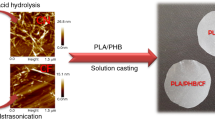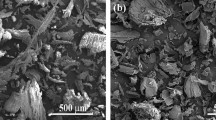Abstract
Bioplastics reinforced by agricultural waste fibres show promise to provide degradation back into the environment when they are no longer needed. These biocomposites have the potential to replace synthetic polymers from non-renewable resources in some applications and may turn out to be one of the material revolutions of this century. Unlike synthetic composites, biocomposites are renewable, carbon neutral, biodegradable and non-petroleum based and have low environmental, human health and safety risks. In this paper, poly(lactic acid) (PLA)-based biocomposites filled with technical cellulose fibres (CeF) and rice husks (RHs) at 10–30 mass% loading were prepared by twin-screw extrusion and injection moulding to enhance stiffness of resulting biocomposites. Particular attention was given to the enhancement of adhesion between the polymer matrix and natural filler through the physical modification by ozone (O3) and dielectric barrier discharge (DBD) plasma (p) surface treatments. Further than, compatibilizing agent based on PLA-g-MAH was produced and introduced into the PLA systems. The non-isothermal crystallization behaviour and thermal properties were investigated through differential scanning calorimetry (DSC) under various cooling rates (5, 10, 20 and 40 °C min−1). The addition of both fillers increased overall crystallization kinetics of resulted biocomposites, especially at high cooling rates. An increase in crystallinity degree from 2.4 (neat PLA) up to 51% has been observed for PLA/30CeFO3 samples at 40 °C min−1 cooling rate. An increase in crystallinity degree based on mass percentage of filler was noticed especially for PLA/RH. Mass percentage increase in CeF did not notice significant increase in PLA crystallinity. The influence of RH and CeF on transformation behaviours of PLA αʹ-/α-polymorphs was observed. The elimination of imperfect αʹ-crystals was observed with increasing amount of RH and CeF.





























Similar content being viewed by others
References
Thakur VK, Thakur MK, Kessler MR. Handbook of composites from renewable materials, Volume 1: structure and chemistry. 1st ed. Hoboken: Wiley; 2017.
Ebnesajjad S. Handbook of biopolymers and biodegradable plastics: properties, processing, and applications. 1st ed. Waltham, MA: Elsevier/William Andrew; 2013.
Xu H, Yang Y, Yu X. Lightweight materials from biopolymers and biofibers. 1st ed. Washington, DC: American Chemical Society; 2014.
Mohanty AK, Misra M, Drzal LT. Natural fibers, biopolymers, and biocomposites. 1st ed. Boca Raton: Taylor and Francis; 2005.
Dartora PC, da Rosa Loureiro M, de Camargo Forte MM. Crystallization kinetics and morphology of poly(lactic acid) with polysaccharide as nucleating agent. J Therm Anal Calorim. 2018. https://doi.org/10.1007/s10973-018-7744-3.
Prapruddivongs C, Rukrabiab J, Kulwongwit N, Wongpreedee T. Effect of surface-modified silica on the thermal and mechanical behaviors of poly(lactic acid) and chemically crosslinked poly(lactic acid) composites. J Thermoplast Compos Mater. 2019. https://doi.org/10.1177/0892705719835286.
Jia S, Yu D, Zhu Y, Wang Z, Chen L, Fu L. Morphology, crystallization and thermal behaviors of PLA-based composites: wonderful effects of hybrid GO/PEG via dynamic impregnating. Polymers. 2017. https://doi.org/10.3390/polym9100528.
Fang Q, Hanna MA. Rheological properties of amorphous and semicrystalline polylactic acid polymers. Ind Crops Prod. 1999. https://doi.org/10.1016/S0926-6690(99)00009-6.
Ding W, Chu RK, Mark LH, Park CB, Sain M. Non-isothermal crystallization behaviors of poly(lactic acid)/cellulose nanofiber composites in the presence of CO2. Eur Polym J. 2015. https://doi.org/10.1016/j.eurpolymj.2015.07.054.
Hamdan MHM, Siregar JP, Rejab MRM, Bachtiar D, Jamiluddin J, Tezara C. Effect of maleated anhydride on mechanical properties of rice husk filler reinforced PLA matrix polymer composite. Int J Precis Eng Manuf-Green Technol. 2019. https://doi.org/10.1007/s40684-019-00017-4.
Haylock R, Rosentrater KA. Cradle-to-grave life cycle assessment and techno-economic analysis of polylactic acid composites with traditional and bio-based fillers. J Polym Environ. 2018. https://doi.org/10.1007/s10924-017-1041-2.
Li Y, Han C, Yu Y, Xiao L, Shao Y. Effect of content and particle size of talc on nonisothermal melt crystallization behavior of poly(L-lactide). J Therm Anal Calorim. 2019. https://doi.org/10.1007/s10973-018-7365-x.
Greco A, Ferrari F, Maffezzoli A. Thermal analysis of poly(lactic acid) plasticized by cardanol derivatives. J Therm Anal Calorim. 2018. https://doi.org/10.1007/s10973-018-7059-4.
Graupner N, Herrmann AS, Müssig J. Natural and man-made cellulose fibre-reinforced poly(lactic acid) (PLA) composites: an overview about mechanical characteristics and application areas. Compos A Appl Sci Manuf. 2009. https://doi.org/10.1016/j.compositesa.2009.04.003.
Murariu M, Dubois P. PLA composites: from production to properties. Adv Drug Deliv Rev. 2016. https://doi.org/10.1016/j.addr.2016.04.003.
Thakur VK, Singha AS. Surface modification of biopolymers. 1st ed. Hoboken: Wiley; 2015.
Kalia S, Thakur K, Celli A, Kiechel MA, Schauer CL. Surface modification of plant fibers using environment friendly methods for their application in polymer composites, textile industry and antimicrobial activities: a review. J Environ Chem Eng. 2013. https://doi.org/10.1016/j.jece.2013.04.009.
Jang JY, Jeong TK, Oh HJ, Youn JR, Song YS. Thermal stability and flammability of coconut fiber reinforced poly(lactic acid) composites. Compos Part B Eng. 2012. https://doi.org/10.1016/j.compositesb.2011.11.003.
Tran TPT, Bénézet JC, Bergeret A. Rice and Einkorn wheat husks reinforced poly(lactic acid) (PLA) biocomposites: effects of alkaline and silane surface treatments of husks. Ind Crops Prod. 2014. https://doi.org/10.1016/j.indcrop.2014.04.012.
Bourmaud A, Pimbert S. Investigations on mechanical properties of poly(propylene) and poly(lactic acid) reinforced by miscanthus fibers. Compos Part Appl Sci Manuf. 2008. https://doi.org/10.1016/j.compositesa.2008.05.023.
Mazzanti V, Pariante R, Bonanno A, Ballesteros OR, Mollica F, Filippone G. Reinforcing mechanisms of natural fibers in green composites: role of fibers morphology in a PLA/hemp model system. Compos Sci Technol. 2019. https://doi.org/10.1016/j.compscitech.2019.05.015.
Di Lorenzo ML, Androsch R. Synthesis, structure and properties of poly(lactic acid). 1st ed. New York: Springer; 2017.
Di Lorenzo ML, Androsch R. Influence of α′-/α-crystal polymorphism on properties of poly(l-lactic acid). Polym Int. 2019. https://doi.org/10.1002/pi.5707.
Zhang C, Lan Q, Zhai T, Nie S, Luo J, Yan W. Melt crystallization behavior and crystalline morphology of polylactide/poly(ε-caprolactone) blends compatibilized by lactide-caprolactone copolymer. Polymers. 2018. https://doi.org/10.3390/polym10111181.
Nagarajan V, Zhang K, Misra M, Mohanty AK. Overcoming the fundamental challenges in improving the impact strength and crystallinity of PLA biocomposites: influence of nucleating agent and mold temperature. ACS Appl Mater Interfaces. 2015. https://doi.org/10.1021/acsami.5b01145.
Arjmandi R, Hassan A, Majeed K, Zakaria Z. Rice husk filled polymer composites. Int Polym Sci. 2015. https://doi.org/10.1155/2015/501471.
Cortés JD, Carriazo JG, Sierra CA, Ochoa-Puentes C. Micro-composites based on polylactic acid with kaolinite or rice husk particles and their performance on water vapor permeability. J Macromol Sci Part A. 2017. https://doi.org/10.1080/10601325.2017.1317580.
Chandrasekhar S, Satayanarayana KG, Pramada PN, Raghavan P, Gupta TN. Review processing, properties and applications of reactive silica from rice husk—an overview. J Mater Sci. 2003. https://doi.org/10.1023/A:1025157114800.
Wen X, Zhang K, Wang Y, Han L, Han C, Zhang H, Chen S, Dong L. Study of the thermal stabilization mechanism of biodegradable poly(l-lactide)/silica nanocomposites. Polym Int. 2010. https://doi.org/10.1002/pi.2927.
Zhang J, Lou J, Ilias S, Krischnamachari P, Yan J. Thermal properties of poly(lactic acid) fumed silica nanocomposites: experiments and molecular dynamics simulations. Polymer. 2008. https://doi.org/10.1016/j.polymer.2008.02.048.
Data sheet Arbocel ZZC 500.
Peters F, Hünnekens B, Wieneke S, Militz H, Ohms G, Viöl W. Corrigendum: comparison of three dielectric barrier discharges regarding their physical characteristics and influence on the adhesion properties on maple, high density fiberboards and wood plastic composite. J Phys D Appl Phys. 2017. https://doi.org/10.1088/1361-6463/aab378.
Battegazzore D, Bocchini S, Alongi J, Frache A. Rice husk as bio-source of silica: preparation and characterization of PLA–silica bio-composites. RSC Adv. 2014. https://doi.org/10.1039/C4RA05991C.
Reig FB, Adelantado JVG, Moreno MCMM. FTIR quantitative analysis of calcium carbonate (calcite) and silica (quartz) mixtures using the constant ratio method. Application to geological samples. Talanta. 2002. https://doi.org/10.1016/S0039-9140(02)00372-7.
Zhang J, Tashiro K, Tsuji H, Domb AJ. Disorder-to-order phase transition and multiple melting behavior of poly(l-lactide) investigated by simultaneous measurements of WAXD and DSC. Macromolecules. 2008. https://doi.org/10.1021/ma0706071.
Saeidlou S, Huneault MA, Li H, Park CB. Poly(lactic acid) crystallization. Prog Polym Sci. 2012. https://doi.org/10.1016/j.progpolymsci.2012.07.005.
Eiras DP, Pessan LA. Influence of calcium carbonate nanoparticles on the crystallization of polypropylene. Mater Res. 2009. https://doi.org/10.1590/S1516-14392009000400024.
Maqsood HS. Cellulose micro/nano particles from jute. Liberec: TU of Liberec; 2016.
Zhou WY, et al. Isothermal and non-isothermal crystallization kinetics of poly(l-lactide)/carbonated hydroxyapatite nanocomposite microspheres. In: Reddy B, editor. Advances in diverse industrial applications of nanocomposites. Rijeka: InTech Europe; 2001. p. 231–60.
Di Lorenzo ML. Crystallization behavior of poly(l-lactic acid). Eur Polym J. 2005. https://doi.org/10.1016/j.eurpolymj.2004.10.020.
Sarasua JR, Prud’homme RE, Wisniewski M, Le Borgne A, Spassky N. Crystallization and melting behavior of polylactides. Macromolecules. 1998. https://doi.org/10.1021/ma971545p.
Dimzoski S, Bogoeva-Gaceva G, Gentile G, Avelle M, Errico ME, Srebrenkoska V. Preparation and characterization of poly(lactic acid)/rice hulls based biodegradable composites. J Polym Eng. 2008;28:369–83.
Acknowledgements
This publication was written at the Technical University of Liberec as part of the project SGS 21280 “Research and development for innovation of materials and production technologies with application potential in mechanical engineering” with the support of the Specific University Research Grant, as provided by the Ministry of Education, Youth and Sports of the Czech Republic in the year 2019 and the European Union—European Structural and Investment Funds in the frames of Operational Programme Research, Development and Education—project Hybrid Materials for Hierarchical Structures (HyHi, Reg. No. CZ.02.1.01/0.0/0.0/16_019/0000843).
Author information
Authors and Affiliations
Corresponding author
Additional information
Publisher's Note
Springer Nature remains neutral with regard to jurisdictional claims in published maps and institutional affiliations.
Rights and permissions
About this article
Cite this article
Běhálek, L., Borůvka, M., Brdlík, P. et al. Thermal properties and non-isothermal crystallization kinetics of biocomposites based on poly(lactic acid), rice husks and cellulose fibres. J Therm Anal Calorim 142, 629–649 (2020). https://doi.org/10.1007/s10973-020-09894-3
Received:
Accepted:
Published:
Issue Date:
DOI: https://doi.org/10.1007/s10973-020-09894-3




